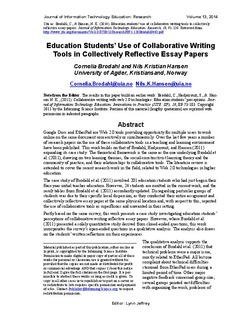| dc.description.abstract | Google Docs and EtherPad are Web 2.0 tools providing opportunity for multiple users to work online on the same document consecutively or simultaneously. Over the last few years a number of research papers on the use of these collaborative tools in a teaching and learning environment have been published. This work builds on that of Brodahl, Hadjerrouit, and Hansen (2011) expanding its case study. The theoretical framework is the same as the one underlying Brodahl et al. (2011), drawing on two learning theories, the social-constructivist learning theory and the community of practice, and their relationships to collaborative tools. The literature review is extended to cover the recent research work in the field, related to Web 2.0 technologies in higher education. The case study of Brodahl et al. (2011) involved 201 education students who had just begun their four-year initial teacher education. However, 24 students are omitted in the current work, and the result tables from Brodahl et al. (2011) accordantly updated. Disregarding particular groups of students was due to their specific local dispersion, as they conducted their entire assignment and collectively reflective essay paper at the same physical location and, with respect to this, reported the use of collaborative tools as superfluous and unwanted in their setting. Partly based on the same survey, this work presents a case study investigating education students' perceptions of collaborative writing reflective essay papers. However, where Brodahl et al. (2011) presented a solely quantitative study derived from closed-ended questions, this work incorporates the survey's open-ended questions in a qualitative analysis. The analysis also draws on the students' written reflections on their experiences. The qualitative analysis supports the conclusion of Brodahl et al. (2011) that technical problems were a major issue, mostly related to EtherPad. All but one complaint about technical difficulties stemmed from EtherPad users during a limited period of time. Other major negative feedback concerned group size; several groups pointed out difficulties with organizing the work, problems ofkeeping track when editing simultaneously, and failure to produce a unified document. Positive issues frequently mentioned are the ability to work asynchronously and from different places. Furthermore, a majority of the reports on commenting on and editing each other's work were positive, mentioning that it is an advantage to be able to correct spelling errors and bad formulations, that it is educational, that one may contribute with ideas that the others do not have, and that it improves the final text. Larger issues on the negative side were fear of insulting or misunderstanding, and difficulties because of various work modes. Also qualitative results indicate that females are more concerned with group size than males, but less preoccupied with technical difficulties. Furthermore, younger students appear more concerned about the importance of preparation and planning than older ones. The major conclusions are that EtherPad and Google Docs facilitate new ways of approaching communication, for different collaborative writing work modes as well as in different settings. However, the setting in which the tool is used exerts an influence on the way students perceive its usefulness. Recommendations derived from students' perception of factors of success for using the collaborative writing tool include the following: group size should preferably not exceed three persons; the students ought to be prepared for technical difficulties and have a contingency plan; and they should have time in advance to discuss their work mode and agree on rules for commenting on and editing each other's work. | nb_NO |
